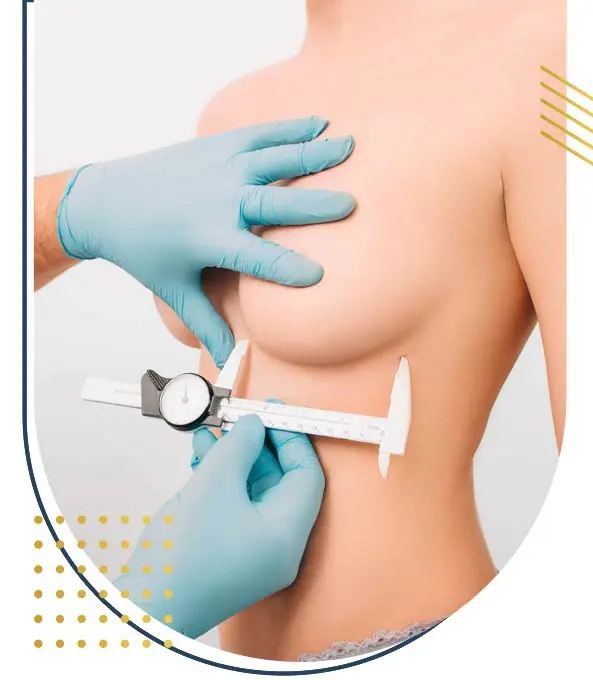
We always encounter women who want to have a more appealing appearance and harmonious bodies. To achieve such a thing, medical procedures are called in and became very common for such practices. The most famous ones are breast remodeling, and for most cases, people talk about breast augmentation.
The thing is that beauty is often linked with breast volume. A lot of women have large breasts and sometimes, it becomes a heavy burden or just too much. Their appearance is hindered because of the unseemly large volume, and therefore, have surgical procedure to reduce it.
What is breast reduction in Egypt ?
Breast reduction in Egypt is a remodeling surgery consisting in the extraction of excessive fat cells existing the breasts. It acts also on the tissues and skins around that area to achieve a convincing result, both aesthetically and physically.
This surgery is performed as a solution related to macromastia or breast hypertrophy which is the fact of having an abnormal breast size.
This can cause great sensations of discomfort in the patient daily life. It can be the source of other physical complications.
The breast reduction in Egypt is becoming increasingly more and more notorious. It is now performed not only on patients with medical problems, like macromastia, but also on patients who want less voluminous breasts. Therefore, this procedure presents a medical and an aesthetical aspect.
Who can have a breast reduction in Egypt ?
Before performing the surgery, on very important element is the selection of the candidate. Not every patient willing to have the procedure can get it.
A series of medical check-ups and analysis are made to make sure that the patient can undergo it.
A good candidate for a breast reduction in Egypt is someone who doesn’t have medical problems, or daily unhealthy habits like smoking, that can affect the procedure. Physical health is a crucial element to consider to avoid further complications after the operation.

What are the types of the Breast reduction procedure ?
Traditional Breast Reduction Surgery :
Traditional breast reduction surgery, also known as reduction mammoplasty, is a time-tested procedure designed to remove excess breast tissue, fat, and skin to achieve smaller, lighter, and more symmetrical breasts.
During this surgery, the plastic surgeon makes carefully planned incisions around the areola, extending vertically downward towards the inframammary fold and sometimes horizontally within the fold itself, creating a "keyhole" or "anchor" pattern.
Through these incisions, excess breast tissue, fat, and skin are meticulously excised, and the remaining breast tissue is reshaped and lifted to create a firmer, more youthful appearance. The nipple-areola complex is often repositioned to a higher, more aesthetically pleasing location on the breast mound.
The incisions are then meticulously closed, resulting in minimal scarring that fades over time. Traditional breast reduction surgery offers long-lasting results and can alleviate a range of physical symptoms associated with large breasts, including back, neck, and shoulder pain, as well as skin irritation and difficulty with physical activity. It also provides a significant improvement in breast aesthetics, enhancing self-confidence and body image.
Vertical or "Lollipop" Breast Reduction :
The vertical or "lollipop" breast reduction technique is a modified approach to traditional reduction mammoplasty that aims to minimize scarring while achieving significant breast reduction and reshaping. This technique involves making a single vertical incision around the areola, extending downward towards the inframammary fold, resulting in a "lollipop" shape.
Through this incision, excess breast tissue, fat, and skin are removed, and the remaining tissue is reshaped and lifted to create a more youthful and proportionate breast contour.
The vertical incision eliminates the need for a horizontal incision within the inframammary fold, reducing the overall length of scars and resulting in a more aesthetically pleasing outcome.
The vertical breast reduction technique is particularly suitable for individuals with moderate to severe breast ptosis (sagging) who desire significant reduction and lift without the extended scarring associated with traditional anchor-shaped incisions. It offers similar benefits in terms of symptom relief, improved breast aesthetics, and enhanced self-confidence.
Scarless Breast Reduction (Liposuction-only Technique) :
Scarless breast reduction, also known as liposuction-only breast reduction or liposculpture, is a minimally invasive alternative to traditional breast reduction surgery that utilizes liposuction techniques to remove excess breast fat and reduce breast volume without the need for visible incisions or scarring.
During this procedure, small incisions are made in inconspicuous locations around the breast, through which a thin cannula is inserted to aspirate excess fat cells from the breast tissue.
By strategically targeting areas of excess fat, the plastic surgeon can achieve significant reduction in breast volume and improve breast contours while preserving glandular tissue and minimizing trauma to surrounding structures.
Scarless breast reduction is an ideal option for individuals with good skin elasticity and minimal breast ptosis who desire modest to moderate reduction in breast size without the risks and recovery associated with traditional surgery. It offers advantages such as shorter procedure time, faster recovery, and minimal scarring, making it an attractive option for those seeking a less invasive approach to breast reduction.
Pedicle Techniques (Inferior, Superior, or Medial Pedicle) :
Pedicle techniques are variations of traditional breast reduction surgery that involve preserving a portion of the breast tissue attached to the nipple-areola complex to maintain blood supply and sensation while reshaping and reducing the breast volume.
The pedicle, which can be positioned inferiorly (below the nipple), superiorly (above the nipple), or medially (towards the sternum), serves as a "flap" of tissue through which blood vessels and nerves are preserved, ensuring adequate circulation and nipple sensation postoperatively. These techniques allow the plastic surgeon to achieve significant reduction in breast size and reshape the breasts while minimizing the risk of nipple necrosis (loss of blood supply to the nipple) and preserving nipple sensation. The choice of pedicle technique depends on factors such as breast size, shape, and ptosis, as well as the surgeon's experience and preference.
Pedicle techniques offer excellent outcomes in terms of breast shape, symmetry, and nipple-areola position, with minimal risk of complications and high patient satisfaction.
Breast Reduction with Free Nipple Grafting :
Breast reduction with free nipple grafting is a specialized technique used to achieve significant reduction in breast size and reshape the breasts in cases where the nipples need to be removed and repositioned higher on the breast mound due to extreme breast ptosis or excessive tissue removal. During this procedure, the plastic surgeon removes the nipple-areola complex as a full-thickness graft, including skin, glandular tissue, and ducts, from its original location on the breast and repositions it higher on the breast mound to achieve the desired nipple position.
The remaining breast tissue is then reshaped and reduced, and the nipple grafts are carefully reattached to the breast mound using meticulous surgical techniques. Breast reduction with free nipple grafting is typically reserved for individuals with severely ptotic breasts or those requiring extensive tissue removal, as it involves a more complex surgical approach and carries a higher risk of nipple necrosis and loss of sensation.
However, it can achieve dramatic improvements in breast shape, symmetry, and contour, providing relief from physical symptoms and enhancing overall breast aesthetics.
How to prepare for a Breast reduction procedure ?
Consultation with a Plastic Surgeon :
The first step in preparing for a breast reduction procedure is to schedule a consultation with a board-certified plastic surgeon who specializes in breast surgery.
During this initial meeting, the surgeon will conduct a thorough evaluation of your medical history, breast anatomy, aesthetic goals, and concerns related to large breasts.
Be prepared to discuss any previous surgeries, medical conditions, medications, allergies, and lifestyle factors, such as smoking or alcohol consumption, that may impact the safety and success of the procedure.
The consultation provides an opportunity to ask questions, express concerns, and discuss expectations regarding the surgery, recovery, and potential outcomes.
Medical Evaluation and Testing :
Prior to undergoing breast reduction surgery, your plastic surgeon will likely perform a comprehensive medical evaluation to assess your overall health and identify any underlying medical conditions or risk factors that may affect your eligibility for surgery or increase the likelihood of complications.
This evaluation may include a physical examination, review of your medical history, laboratory tests, and diagnostic imaging studies, such as mammography or breast ultrasound, to evaluate breast tissue and detect any abnormalities.
It's essential to be transparent about your medical history and disclose any relevant information to ensure the safety and success of the procedure.
Discussion of Surgical Options and Expectations :
During the consultation process, your plastic surgeon will discuss the various surgical options available for breast reduction and help you understand the potential risks, benefits, and limitations of each approach.
This includes discussing incision patterns, surgical techniques, expected changes in breast size and shape, nipple-areola position, scarring, and potential complications. Your surgeon will work with you to develop a personalized treatment plan that aligns with your goals, preferences, and anatomical considerations, ensuring that you have realistic expectations and a clear understanding of what to expect from the procedure.
Preoperative Instructions and Lifestyle Adjustments :
In the weeks leading up to your breast reduction surgery, your plastic surgeon will provide you with specific preoperative instructions to follow to help optimize your safety and surgical outcomes. These instructions may include guidelines regarding medications to avoid before surgery, dietary restrictions, smoking cessation, and skincare protocols.
It's essential to adhere to these instructions diligently to minimize the risk of complications and ensure a smooth recovery process.
Additionally, your surgeon may recommend lifestyle adjustments, such as maintaining a stable weight, practicing good nutrition, staying hydrated, and engaging in regular exercise, to promote overall health and facilitate optimal healing.
Arranging for Care and Support :
Breast reduction surgery is a significant surgical procedure that requires careful planning and support during the recovery process.
It's advisable to arrange for a responsible adult to accompany you to the surgical facility on the day of the procedure and to provide assistance and support during the immediate postoperative period.
Additionally, you may need to make arrangements for childcare, pet care, and household responsibilities to ensure a stress-free recovery at home. Having a support system in place can help alleviate anxiety and facilitate a smoother transition from surgery to recovery.
Preoperative Assessment of Breast Anatomy and Symmetry :
As part of the preoperative planning process, your plastic surgeon will assess your breast anatomy, size, shape, symmetry, and nipple-areola position to determine the most appropriate surgical approach and achieve optimal aesthetic outcomes.
This may involve taking measurements, photographs, and performing breast examinations to evaluate tissue density, skin elasticity, and nipple-areola complex position. Your surgeon will work with you to establish realistic goals and expectations for the surgery, taking into account your unique anatomical features and aesthetic preferences.
Finalizing Surgical Plan and Informed Consent :
Prior to undergoing breast reduction surgery, your plastic surgeon will review the proposed surgical plan with you in detail, including the chosen incision pattern, surgical technique, expected changes in breast size and shape, and potential risks and complications.
You will also be asked to sign a surgical consent form, indicating that you understand the nature of the procedure, its associated risks, and alternative treatment options. Take this opportunity to ask any remaining questions or address any concerns you may have before proceeding with surgery.
Breast reduction in Egypt, how is it done ?
After checking that the candidate is a good one, the surgeon prepares to perform the surgery. The procedure is done under general anaesthesia.
The surgeon, depending on the situation, proceeds into making the appropriate type of incision. Existing in three following options.
- The circular incision (around the areola area)
- The Keyhole incision (around the areola and down the breast crease)
- The inverted T
After which the surgeon starts removing the excess of fat and other tissues along the way that are not needed. The repositioning of the breast is done afterward, by lifting and reshaping it. In some cases, the areola needs to be cut out and transplanted in the appropriate position, known also as the free nipple graft.
After everything is done and well positioned, the surgeon proceeds to suture the incisions. To get a good support to the new breast, the sutures must be done deep enough to allow such thing.
What to expect after a breast reduction surgery in Egypt ?
Following the surgery, elastic bandages will be applied to the breasts to ensure the appropriate support. The expected full recovery from breast reduction may go from 15 up to 60 days, depending on the patient's case.
The sensations of discomfort will accompany the patient for two weeks before getting better. Trying to avoid any strenuous physical activity is recommended. This is to make sure the recovery is done well in the least amount of time.
What are the results of breast reduction in Egypt ?
The results after the surgery are immediately visible. The size should be more harmonious with the rest of the body. Some scars are permanent, but in some cases, they can start fading away with time.
The patients will have obtained a long-lasting breast reduction result that will help in improving the quality of their lives.
What is the price of a breast reduction in Egypt ?
To obtain the price breast reduction Egypt, ask for a free online quote or contact us by phone for more details.
What are the risks of the Breast reduction procedure ?
Bleeding and Hematoma :
Excessive bleeding during or after surgery can lead to the formation of a hematoma, which is a collection of blood that accumulates under the skin.
While small hematomas may resolve on their own, larger ones may require surgical drainage to prevent complications such as infection or impaired wound healing.
Infection :
Infection is a potential risk following any surgical procedure, including breast reduction. Although rare, infections can occur in the incision sites or within the breast tissue, leading to symptoms such as pain, redness, swelling, and fever.
Prompt treatment with antibiotics may be necessary to resolve the infection and prevent further complications.
Poor Wound Healing :
Some individuals may experience delayed wound healing or wound breakdown following breast reduction surgery, particularly if they have certain risk factors such as smoking, diabetes, or compromised immune function.
This can result in delayed recovery, prolonged discomfort, and increased risk of infection.
Changes in Nipple Sensation :
Breast reduction surgery can sometimes result in changes in nipple sensation, including temporary or permanent numbness, hypersensitivity, or altered sensation. While most individuals experience some degree of sensory changes initially, sensation typically improves over time as the nerves regenerate.
Nipple and Areola Complex Complications :
Changes in nipple-areola complex sensation, shape, or position can occur following breast reduction surgery, particularly if extensive tissue removal or repositioning is required. In rare cases, loss of blood supply to the nipple-areola complex (necrosis) may occur, necessitating surgical intervention to preserve tissue viability.
Scarring :
All surgical procedures result in some degree of scarring, and breast reduction surgery is no exception. The extent and visibility of scarring can vary depending on factors such as incision pattern, skin quality, and individual healing characteristics. While efforts are made to minimize scarring and achieve aesthetically pleasing results, some degree of scarring is inevitable.

Asymmetry :
Despite meticulous surgical technique and careful planning, subtle differences in breast size, shape, or symmetry may occur following breast reduction surgery. While minor asymmetries are normal and often imperceptible, significant discrepancies may require revision surgery to achieve optimal balance and proportion.
Changes in Breastfeeding Ability :
Breast reduction surgery can impact breastfeeding ability by altering the anatomy of the breast and potentially affecting milk production and flow.
While many individuals are still able to breastfeed successfully following breast reduction, there is a risk of decreased milk supply or difficulty with breastfeeding, particularly if significant glandular tissue is removed during surgery.
Unsatisfactory Aesthetic Results :
Despite careful planning and skilled surgical technique, some individuals may be dissatisfied with the aesthetic results of breast reduction surgery.
This can include issues such as asymmetry, contour irregularities, or inadequate reduction in breast size. Revision surgery may be necessary to address these concerns and achieve the desired outcome.

